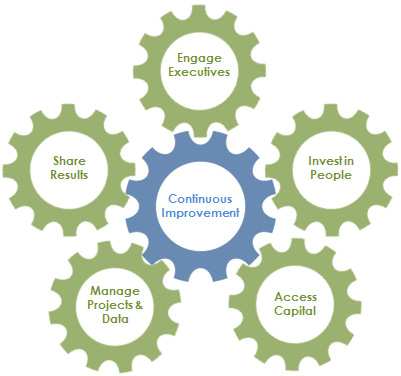
A framework for successful organizational energy management programs
Since 2008, EDF Climate Corps has worked closely with nearly 400 organizations to cut energy costs and curb carbon emissions. Along the way it has surfaced the common barriers to energy management and identified the most powerful strategies for breaking them down.
The Virtuous Cycle of Strategic Energy Management [PDF], developed in collaboration with the MIT Sloan School of Management, provides a framework for understanding how an organization can overcome internal barriers and create a cycle of continuous improvement for energy management. The drivers influencing energy management decision-making can be grouped into five interdependent organizational functions (see image above). If the performance of one function improves, it often improves the performance of other functions, creating a "virtuous cycle" of positive feedback. When all functions are aligned, the cycle will run smoothly to improve energy performance, generating maximum financial and environmental returns. Conversely, lack of progress or barriers encountered in one function can halt progress and have a negative effect on other areas.
Read the summary below or download the Virtuous Cycle of Strategic Energy Management PDF for more detail.
Engage Executives
In this function, the goal is for top-level executives to recognize energy efficiency as a key strategic priority for generating cost savings and building long-term value in a business. They shift from seeing energy-use as an inevitable and growing cost, to a source of leverage for building an efficient and resilient organization, capable of meeting its broader mission and goals.
Invest in People
Here, resources are deployed to build staff capabilities and equip them to go after efficiency opportunities. Providing training opportunities, organizing cross functional teams and establishing fulltime positions helps to build employee knowledge, foster enthusiasm and create accountability for improvement. A workforce that feels ownership and responsibility for its energy use at all levels and is actively encouraged by leadership to work toward a shared vision of efficiency will maintain the momentum needed to make real progress.
Resources are deployed to build staff capabilities and equip them to go after efficiency opportunities.
Access Capital
To empower their organization to capture energy savings, executives make strategic, capacity-building investments to free up the financial resources necessary for concrete action. Energy efficiency projects will pay for themselves, but they need dedicated seed capital to get started and attentive managers to ensure those initial funds grow, and are reinvested, on an ongoing basis.
Manage Projects and Data
To aid the organization's staff, effective processes and tools are developed and refined over time. This ensures that increasingly ambitious projects are identified and implemented, and results are measured and verified. Comprehensive and detailed energy data collection is vital to identifying sources of inefficiency and measuring the energy savings achieved through specific interventions — generating the verified financial and environment results that prove the benefits of taking action in the first place.
Share Results
To maintain momentum beyond a first round of projects, successful results are leveraged into stories that are shared directly back with top executives. These narratives validate the organization’s decision to prioritize energy efficiency as a key strategy and prove the business case for undertaking additional energy projects. By continuously reengaging the executives, success stories keep energy performance at the top of the agenda and encourage the investment of additional human and financial resources to go after even bigger wins, keeping the virtuous cycle spinning for yet another round.